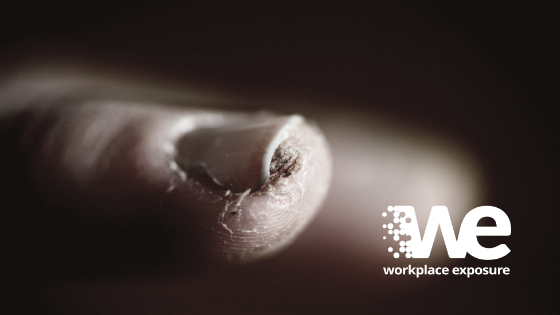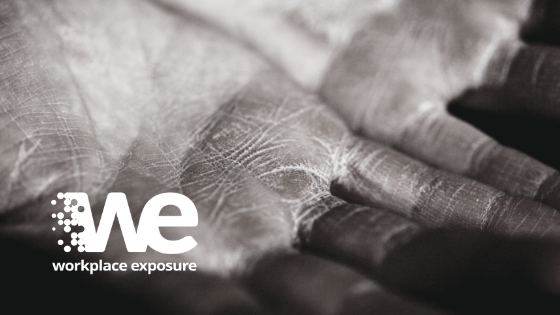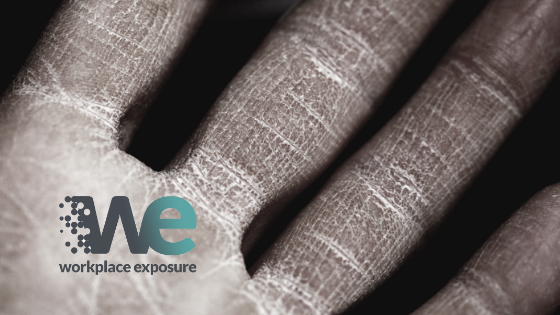Occupational Contact Dermatitis
This article provides guidance to support employers in their efforts to protect workers from occupational contact dermatitis.
It offers a general overview of activities and substances that may cause harm and identifies practical steps for controlling the risks.
This article is also primarily intended to raise awareness of the standards employers need to meet, in order to comply with the Control of Substances Hazardous to Health Regulations 2002 (COSHH), as amended, to control exposure and protect workers’ health.
What is Occupational Contact Dermatitis?
Dermatitis is a common skin condition, defined by the NHS as ‘a type of eczema triggered by contact with a particular substance’. Substances can cause skin damage in one of two ways:
- irritant contact dermatitis
- allergic contact dermatitis

Irritant Contact Dermatitis
Irritant contact dermatitis accounts for the majority of cases of contact dermatitis, occurring when the skin is exposed to a toxic or chemical substance, or even prolonged or repeated contact with water, such as hand washing (known as wet work). This repeated contact then results in direct damage.
Some of these substances are extremely irritating and can cause the skin to change within a few minutes, whereas others are less irritating and occur with frequent or prolonged exposure.
Allergic contact dermatitis
Allergic contact dermatitis, on the other hand, is a delayed reaction. Skin contact with the allergen causes a hypersensitivity response from the immune system, but the actual skin reaction to it (sense and visible) occurs the next time there is exposure to that substance to which a person has become sensitised.
The most common substances causing allergic contact dermatitis often change with time, as certain chemicals come in or out of use in the manufacture of products that come in contact with the skin.
There are a wide variety of occupations that can be susceptible to contact dermatitis, ranging from healthcare to hairdressing, and either irritant or allergic. However, the symptoms can be both painful and debilitating for the sufferer.
What are the Symptoms of Occupational Contact Dermatitis?
The hands are by far the most commonly affected part of the body, followed by the face.
This is unsurprising given the fact that contact dermatitis accounts for the majority of cases of workplace dermatitis in the UK and that the hands and face are the two areas of the body that are most frequently exposed in the workplace.
The signs and symptoms of the different types of dermatitis are similar. It initially presents itself as a dry, red and itchy rash, confined to a specific area of the skin, and is often followed by flaking, blistering or swelling.
Sometimes the symptoms are immediately visible; sometimes they are not. It is important to remain vigilant, as the effects can be cumulative.

How to Perform an Occupational Risk Assessment for Contact Dermatitis?
For any organisation it is the legal responsibility of the employer to ensure that any skin hazards are identified for substances used or generated in the workplace.
For best practise, we recommend regularly checking labels and safety data sheets, as well as referring back to industry guidance.
The risk assessment must take into account dermal exposure pathways in the occupational environment, such as immersion, deposition, splashes, or contact with contaminated surfaces.
It is important to note that prolonged or frequent contact with water (often referred to as ‘wet work’), particularly in combination with soaps and detergents, can also result in contact dermatitis.
How to Adequately Control Occupational Dermal Risks Following the ‘APC’ Approach
Adequate control of dermal risks may not be achieved by a single working practice and often requires a combination of control measures. HSE recommends that employers adopt an ‘APC’ approach:
- Avoid or reduce contact with materials that cause dermatitis by substituting a hazardous substance or introducing equipment for handling.
- Protect workers’ skin by providing personal protective equipment and informing employees of any work-related dangers.
- Check regularly for early signs or symptoms of contact dermatitis.
It is always advisable to consult an occupational hygienist, such as ourselves, to help assess and control your employees exposure to hazardous substances and to provide advice in relation to workplace health risk assessments.
We’re here to help
At Workplace Exposure, we support employers in their efforts to protect employees, visitors and customers from exposure to substances hazardous to health, as well as offer professional solutions and advice. Find out more about our health & safety consultancy work or get in touch with us today.
Our approach
Get in touch with Workplace Exposure. Either give us a call on 0800 689 4386, or fill in our enquiry form to discuss your monitoring or consultancy requirements.
We’ll then provide you with a no-obligation proposal, we can often give an initial idea of fees whilst we discuss your needs.
Once you’ve accepted our proposal we can then schedule the work.
Following our site visit we’ll provide you with a comprehensive report giving you advice, recommendations and control measures where appropriate. Implement the outcomes for compliance and a happier healthier workplace.
